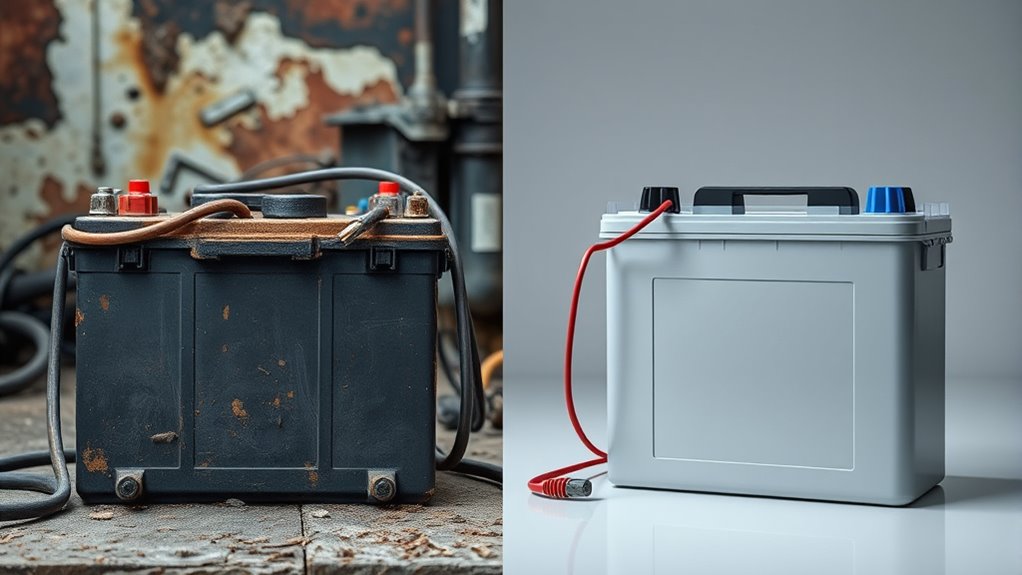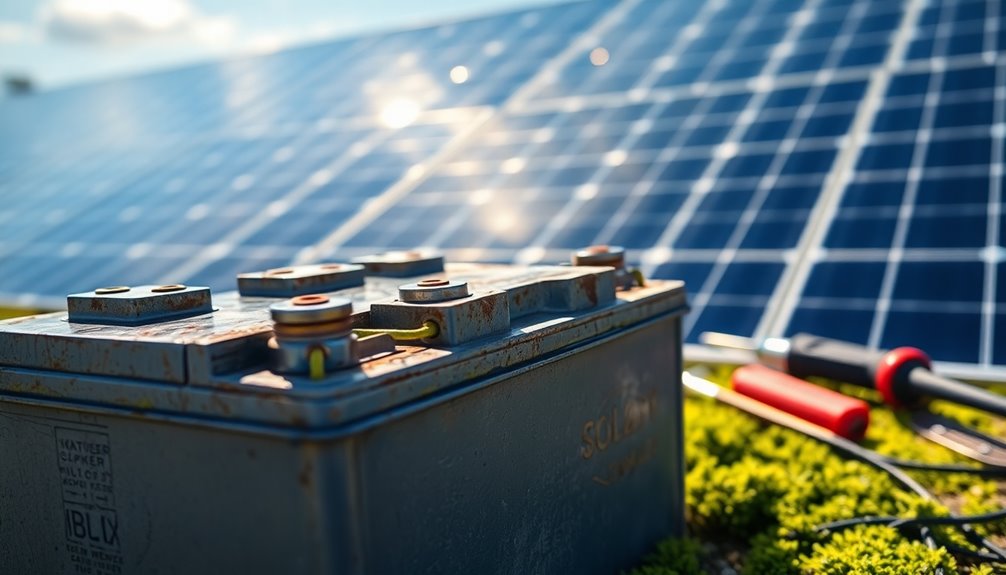When reconditioning lead-acid and lithium batteries, you need to follow different rules due to their distinct chemistries. Lead-acid batteries are easier and safer to recondition with simple procedures like equalizing charges and sulfation removal. Lithium batteries require careful handling, specialized equipment, and strict adherence to manufacturer guidelines to avoid hazards. Knowing these differences guarantees proper maintenance and safety—continue exploring to learn detailed procedures and best practices for each type.
Key Takeaways
- Lead-acid batteries are easier and more cost-effective to recondition through simple maintenance like equalizing charges.
- Lithium batteries require specialized equipment and careful handling due to their sensitive chemistry during reconditioning.
- Reconditioning lead-acid batteries involves sulfation removal, while lithium batteries focus on balancing and safety protocols.
- Lead-acid reconditioning is well-established with standard procedures, whereas lithium reconditioning is more complex and less common.
- Proper reconditioning rules differ significantly, emphasizing safety and manufacturer guidelines for lithium versus straightforward methods for lead-acid.

Are lead-acid and lithium batteries truly the best options for your energy needs? When comparing these two types, understanding their differences in battery chemistry is essential. Lead-acid batteries rely on a chemical reaction involving lead plates and sulfuric acid, which makes them relatively simple and cost-effective. Lithium batteries, on the other hand, use lithium ions moving between electrodes, offering higher energy density and longer lifespan. These fundamental differences influence how you approach reconditioning and recycling. Lead-acid batteries are easier to recondition because their chemistry allows for straightforward maintenance, like equalizing charges and removing sulfation buildup. Lithium batteries require more careful handling during reconditioning due to their sensitive battery chemistry, which can be damaged if not treated properly. It’s necessary to follow manufacturer guidelines and use specialized equipment to restore their capacity effectively. Additionally, the refresh rate of lead-acid batteries is generally more stable, making them suitable for certain applications.
Recycling processes also vary considerably between these batteries. Lead-acid recycling is a well-established industry, with over 95% of the materials being recoverable. The process involves draining the acid, crushing the batteries, and separating the lead, plastic, and remaining components for reuse. This efficient recycling cycle makes lead-acid batteries environmentally friendly and cost-effective to manage. Lithium batteries, however, pose more complex challenges. Their recycling process involves disassembling the cells and extracting valuable metals like lithium, cobalt, and nickel. These processes are more energy-intensive and require advanced technology to guarantee safety and environmental protection. Because lithium batteries contain potentially hazardous materials, improper recycling can lead to environmental damage or health risks. Consequently, proper disposal and recycling are essential, especially as lithium battery use expands in electric vehicles and portable electronics.
When considering reconditioning, it’s essential to recognize that lead-acid batteries can often be restored with simpler procedures, which makes them attractive for those seeking cost-effective solutions. Lithium batteries, while more durable and efficient, demand precise reconditioning techniques to avoid safety hazards and preserve their longevity. Recycling processes for lead-acid batteries are mature and reliable, making them a sustainable choice for many applications. Lithium batteries, although more complex to recycle, offer the advantage of recovering high-value materials that can be reused in new batteries. Ultimately, your decision should factor in not just initial performance but also the long-term sustainability and environmental impact, which are heavily influenced by each battery’s chemistry and recycling options.
Frequently Asked Questions
Can Lithium Batteries Be Reconditioned Like Lead-Acid Batteries?
You can’t recondition lithium batteries like lead-acid ones because battery chemistry differs considerably. Reconditioning techniques for lithium batteries are more complex and often risky, involving specialized knowledge and equipment. Attempting to recondition lithium batteries without proper expertise can lead to safety hazards, including fires. Always follow manufacturer guidance and avoid DIY methods. Proper maintenance extends lithium battery life, but reconditioning isn’t typically recommended or feasible compared to lead-acid batteries.
What Safety Precautions Are Necessary When Reconditioning Lithium Batteries?
When reconditioning lithium batteries, you must prioritize battery safety and handling precautions. Always wear protective gear, including gloves and goggles, to prevent chemical exposure or fires. Work in a well-ventilated area and avoid puncturing or short-circuiting the battery. Follow manufacturer guidelines carefully and use proper tools. These handling precautions help minimize risks associated with lithium batteries, ensuring safer reconditioning processes and preventing potential hazards.
How Do Reconditioning Methods Differ Between Lead-Acid and Lithium Batteries?
When reconditioning batteries, you need to understand that battery chemistry influences the techniques you use. For lead-acid batteries, reconditioning involves equalizing charges, checking fluid levels, and removing sulfation. Lithium batteries require careful management of voltage levels and avoiding overcharging or deep discharging. You must follow specific reconditioning techniques tailored to each chemistry to guarantee safety and effectiveness, as improper methods can damage batteries or pose safety risks.
Is Reconditioning Effective for All Types of Lithium Batteries?
Is reconditioning a magic wand for all lithium batteries? Not quite. You see, lithium batteries have a limited battery lifespan and charging cycles, making reconditioning less effective over time. While some methods can help extend their life, they don’t work universally for every type. Think of it like trying to revive a fading star—sometimes, the damage is too deep, and reconditioning just isn’t enough to restore full capacity.
What Are the Environmental Benefits of Reconditioning Lithium Versus Lead-Acid Batteries?
Reconditioning lithium batteries offers environmental benefits by reducing waste and promoting battery recycling, which minimizes the environmental impact. Unlike lead-acid batteries, lithium reconditioning helps extend battery life without harmful chemicals, decreasing hazardous waste. You can contribute to sustainability by reconditioning batteries, conserving raw materials, and reducing pollution. This process supports eco-friendly practices and helps lessen the overall environmental footprint associated with battery disposal and manufacturing.
Conclusion
When reconditioning batteries, it’s vital to understand the differences between lead-acid and lithium types. Did you know that lead-acid batteries can often be restored up to 80% of their original capacity with proper reconditioning? Lithium batteries, however, require more careful handling and specific procedures. By following the right guidelines, you can extend your battery’s lifespan and save money. Remember, knowing these distinctions helps you make smarter, safer choices for your energy needs.










